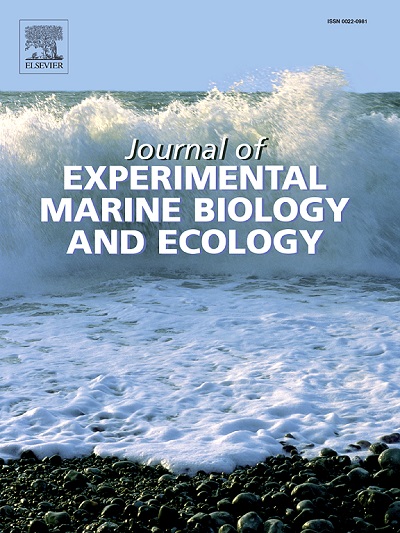温度影响赤潮蟹幼蟹的生长速率,饲料脂肪影响赤潮蟹幼蟹的状态指标。
IF 1.8
3区 生物学
Q3 ECOLOGY
Journal of Experimental Marine Biology and Ecology
Pub Date : 2025-05-05
DOI:10.1016/j.jembe.2025.152105
引用次数: 0
摘要
自20世纪80年代以来,阿拉斯加的唐纳蟹(Chionoecetes bairdi)数量一直在下降。不断上升的海洋温度被假设为区域螃蟹数量减少的驱动因素,这既通过对其代谢率的直接热效应,也通过对捕食-猎物相互作用和可用食物质量的间接影响。较低的幼蟹能量储存和较高的代谢率可能使其生命早期阶段比成年蟹更容易受到变暖引起的饥饿。为了表征温度和饲料质量(%脂质)对幼年唐纳蟹存活、生长、脂质组成和状态指标的潜在协同影响,我们于2022年夏季在阿拉斯加Kodiak的苗场收集了0岁的蟹。我们进行了一项为期11个月的生长实验,在三种温度(2、5和9°C)和两种膳食脂质水平(低和高)下,在单个细胞中饲养螃蟹。在蜕皮一周内收集形态测量数据,并在第二个完整蜕皮周期后的蜕皮中期或11个月培养结束时采集全身脂质样本。结果表明,温度显著影响雏菊的生长和存活,在9℃条件下,雏菊的蜕皮间隔期短,死亡率高。以形态计量学为基础的情况变化很大,不同处理之间无显著差异。相比之下,基于脂肪的状况指标显示,与喂食低脂饲料的螃蟹相比,喂食高脂饲料的螃蟹每体重的甘油三酯和总脂肪含量更高。高温饲养的蟹比低温饲养的蟹具有更高的甾醇和饱和脂肪酸比例。我们在这个完全交叉实验中的发现表明,阿拉斯加水域温度的升高有可能通过加速生长直接影响幼蟹种群,并通过减少底栖食物网中可用的脂质含量间接影响幼蟹种群。本文章由计算机程序翻译,如有差异,请以英文原文为准。
Temperature affects growth rates while dietary lipid influences condition metrics in juvenile Tanner crab (Chionoecetes bairdi)
Tanner crab (Chionoecetes bairdi) populations in Alaska have declined since the 1980s. Increasing ocean temperatures have been hypothesized to be a driver of regional crab declines, both via direct thermal effects on their metabolic rates and through indirect effects on predatory-prey interactions and available food quality. Lower juvenile crab energy storage and higher metabolic rates may make early life stages more vulnerable to warming-induced starvation than adults. To characterize the potential synergistic influence of temperature and diet quality (% lipid) on juvenile Tanner crab survival, growth, lipid composition and condition metrics, we collected age-0 crab from nursery grounds in Kodiak, Alaska, during the summer of 2022. We performed an 11-month growth experiment in which crab were reared in individual cells under three temperatures (2, 5, and 9 °C) and on two dietary lipid levels (low and high). Morphometric data were collected within one week of molting and whole-body lipid samples were taken at mid-molt following the second full molt cycle, or at the end of 11 months of culture. Results show that temperature significantly impacted growth and survival, with shorter intermolt periods and high mortality observed at 9 °C. Morphometric-based condition was highly variable and not significantly differ between treatments. In contrast, lipid-based condition metrics revealed that crab fed high dietary lipids had elevated triacylglycerols and total lipids per weight relative to crab fed low-lipid diets. Crab reared in elevated temperatures had higher proportions of sterols and saturated fatty acids than crab at low culture temperatures. Our findings in this fully crossed experiment suggest that increasing temperatures in Alaska waters have the potential to impact juvenile crab populations both directly through accelerated growth and indirectly via declining lipid content available in the benthic food web.
求助全文
通过发布文献求助,成功后即可免费获取论文全文。
去求助
来源期刊
CiteScore
4.30
自引率
0.00%
发文量
98
审稿时长
14 weeks
期刊介绍:
The Journal of Experimental Marine Biology and Ecology provides a forum for experimental ecological research on marine organisms in relation to their environment. Topic areas include studies that focus on biochemistry, physiology, behavior, genetics, and ecological theory. The main emphasis of the Journal lies in hypothesis driven experimental work, both from the laboratory and the field. Natural experiments or descriptive studies that elucidate fundamental ecological processes are welcome. Submissions should have a broad ecological framework beyond the specific study organism or geographic region.
Short communications that highlight emerging issues and exciting discoveries within five printed pages will receive a rapid turnaround. Papers describing important new analytical, computational, experimental and theoretical techniques and methods are encouraged and will be highlighted as Methodological Advances. We welcome proposals for Review Papers synthesizing a specific field within marine ecology. Finally, the journal aims to publish Special Issues at regular intervals synthesizing a particular field of marine science. All printed papers undergo a peer review process before being accepted and will receive a first decision within three months.

 求助内容:
求助内容: 应助结果提醒方式:
应助结果提醒方式:


